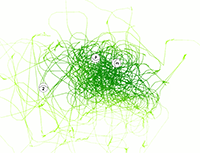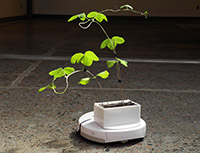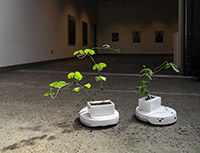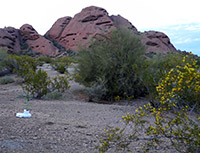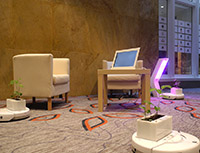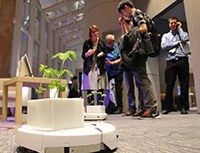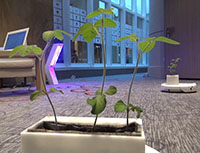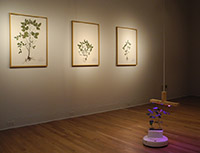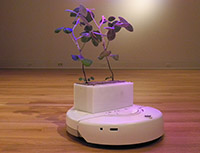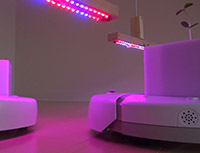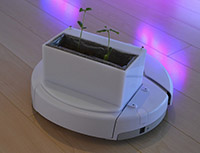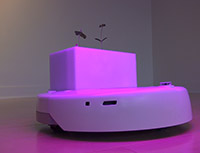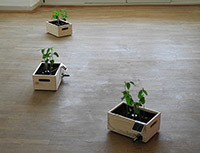Gardens express ideas and social relations; Soybots: Mobile
Micro-Gardens, a responsive robotic-botanic hybrid artwork that utilizes
light sensors to track sunlight intensity or to locate LED grow lights,
so that soybean plants can motor to ideal photosynthetic locations
represents a speculative installation that suggests questions about
agricultural and robotic futures implicated in contemporary practices
and values.
Description
A small fleet of autonomous robotic platforms, outfitted with custom
planter boxes containing soybean plants, roams the gallery in search of
optimal light conditions for plant growth. The robots' movements are based
on a phototropic control strategy, using sensors to track and follow
sunlight intensity or to locate LED grow lights. However, individual
robots can also be guided or distracted by flashlight beams aimed at their
sensors. The soybean plants in this work were chosen for their significance
for global food production and also because of their strong association
with a hybridity between nature and technology - in this case as a result
of biotechnological strategies for increasing crop yields through genetic
modification. As self-pollinating organisms—paired with a light-seeking
mobile platform, they also metaphorically address increasingly independent
botanical/technological hybrids. Gardens merit attention as locations
where art and technology produce material realities and social narratives
with political consequences. Soybots belongs to a longer investigation of
gardens as sites for critical reflection that started with the
National Security Garden public artwork. The artists
see this work as a speculative installation that suggests questions about
agricultural and robotic futures implicated in contemporary practices and
values. Specifically, the project attempts to translate and interpret
what plants need into code that drives the behavior of the robots.
While roaming through architectural space, each robot transmits both sensor
data and positional coordinates to a visualization window in the gallery.
The upper half of the window plots positional data in real-time as lines:
dense in areas of high light levels and sparse in darker areas. This part
of the visualization connects architectural space to movement and light,
while the lower part of the window displays statistical information,
comparing average light values and distance traveled at the end of each
day. Making this interface visible to visitors inspires thought about
energy need, consumption and balance - comparing forms of sun and
electrical energy. As one observer of the work has remarked this graphical
representation also suggests that "the process of photosynthesis is more
deeply entangled with technology and cultural-based ecologies than perhaps
previously imagined. Rather than being simply a translation of light into
plant matter, photosynthesis extends through food webs to include the
relationship between humans and technology."

